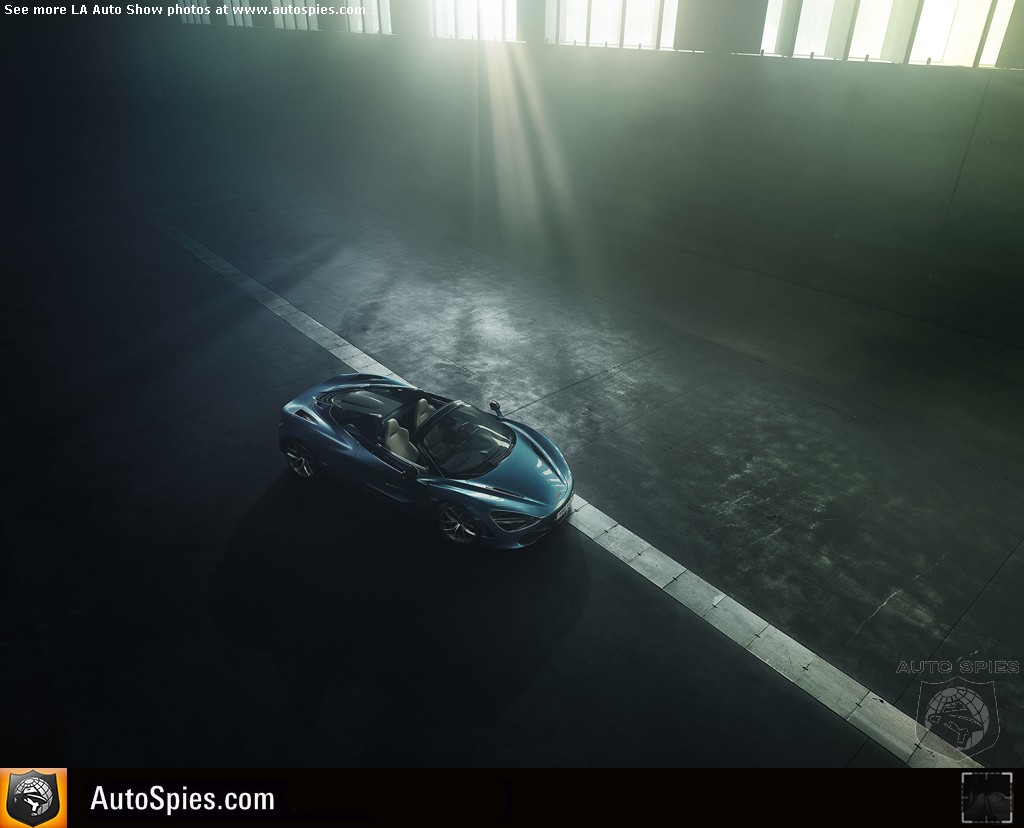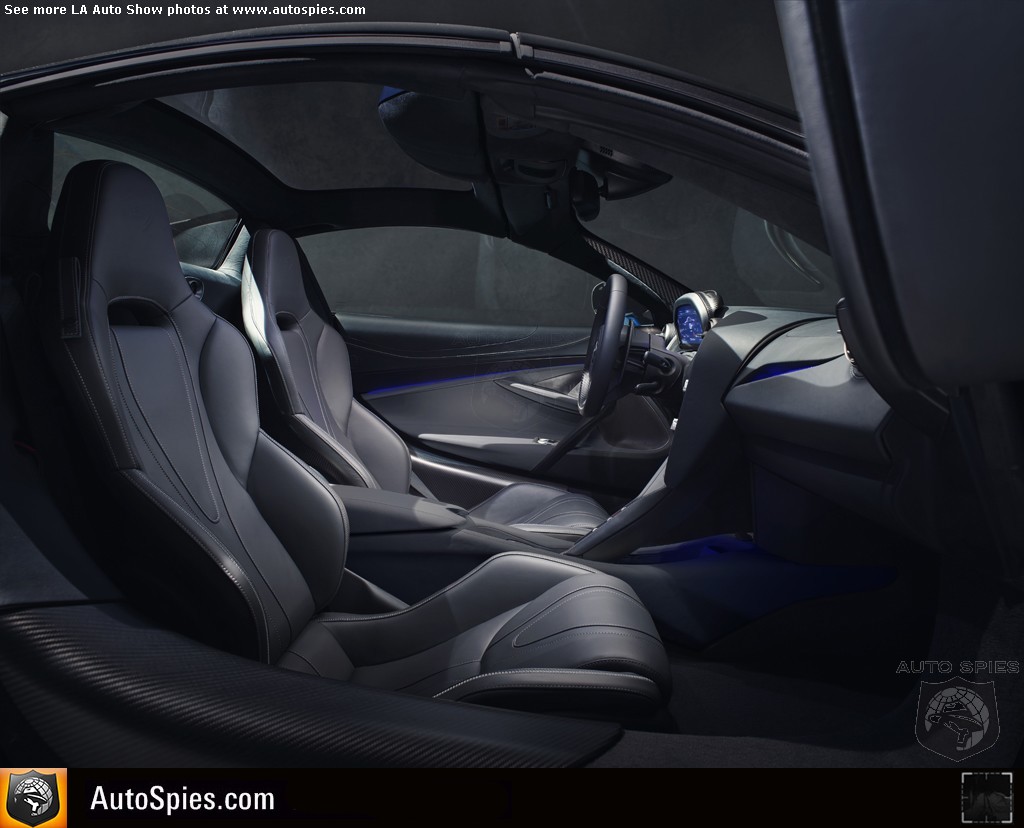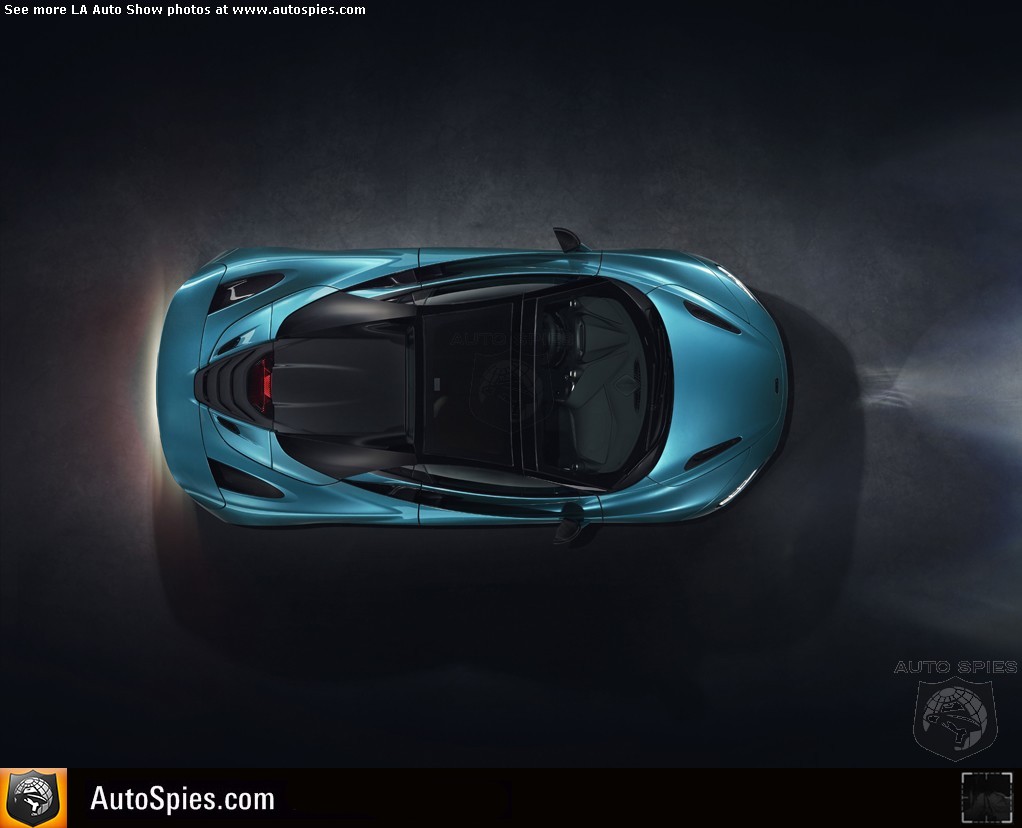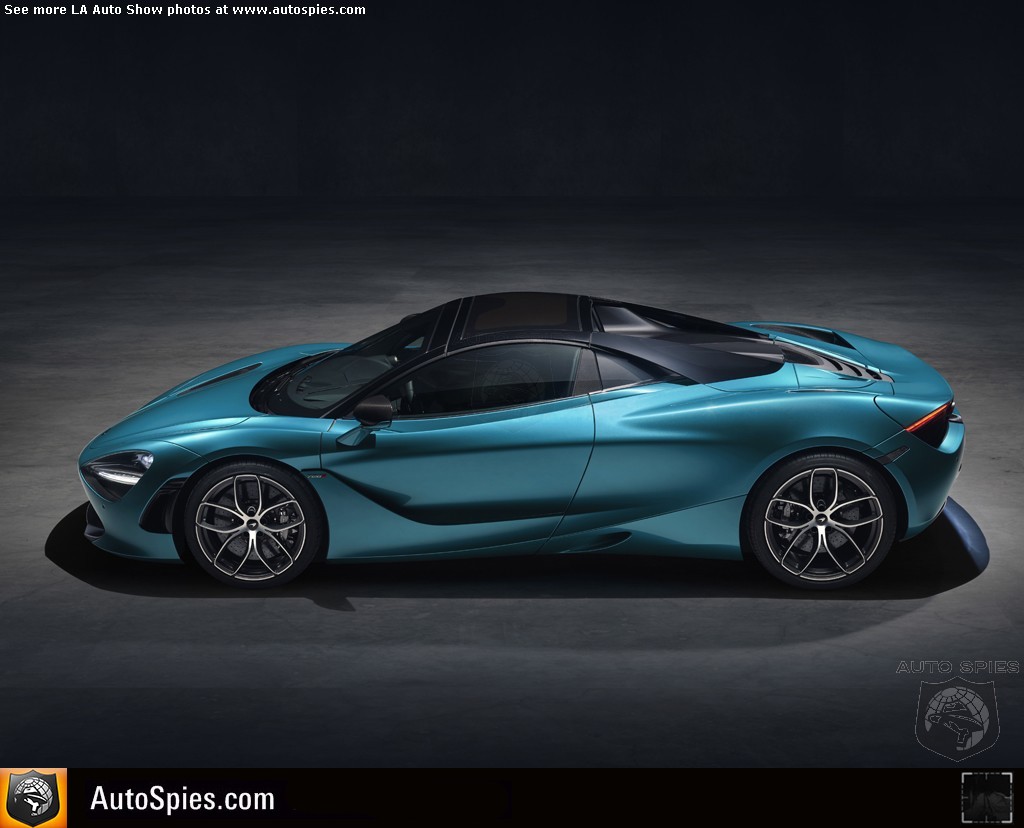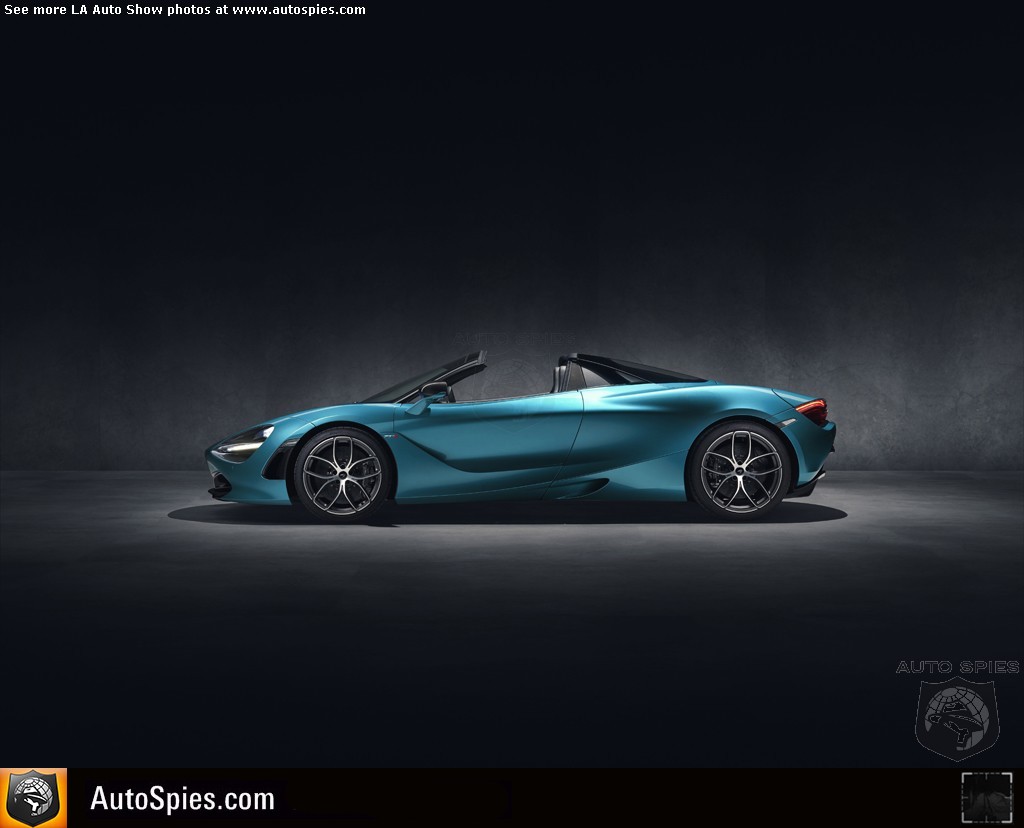McLaren's press release follows:
McLaren Automotive lights up the supercar class with new 720S Spider
- New 720S Spider the most accomplished convertible supercar ever from McLaren, combining the thrill of open-air driving with unparalleled Super Series dynamic performance and sophistication
- Light, stiff and extremely strong Monocage II-S carbon fibre core features integrated rollover protection structure (ROPS); needs no additional strengthening over Coupé, ensuring a convertible without compromise and guaranteeing exceptional dynamic agility
- Bespoke carbon fibre body structure and new Retractable Hard Top (RHT) support a lightest dry weight of 2,937lbs – lightest in class at just 108lbs more than the 720S Coupé and 194lbs less than the dry weight of its closest competitor
- Unparalleled visibility due to unique, glazed flying buttresses that also accentuate aerodynamic purity of design and increase downforce
- Patented new carbon fibre roof system is electrically actuated and delivers fastest-operating time in the supercar class, lowering or raising in 11 seconds at vehicle speeds of up to 31mph
- Retractable Hard Top is available glazed with an electrochromic glass panel that can rapidly switch between tinted and transparent states
- 4.0-liter twin-turbocharged McLaren V8 engine produces 710 bhp and 568lb ft of torque, with a power-to-weight ratio for 720S Spider at lightest dry weight of 533 bhp/ton
- Acceleration from 0-60mph is same as 720S Coupé at 2.8 seconds; 0-124mph in 7.9 seconds; maximum speed with roof raised 212mph – roof lowered 202mph
- Active rear spoiler aerodynamics automatically tuned to closed- or open-roof driving
- 720S Spider is second new model under £1.2bn McLaren Automotive Track25 business plan
- Deliveries to customers commence March 2019; US prices start from $315,000
McLaren Automotive, the British manufacturer of luxury, high-performance sportscars and supercars, is expanding its Super Series product family with the introduction of a second new model under the £1.2bn Track25 business plan and its most accomplished convertible supercar ever: the new 720S Spider.
McLaren 720S Spider

Revealed online today, December 8, 2018 and available to order with immediate effect, the new 720S Spider delivers the exhilaration of open-air driving and levels of day-to-day usability unseen in the convertible supercar class.
“The new McLaren 720S Spider offers an unparalleled blend of extreme performance, crafted luxury, driver involvement and daily usability – all with the additional exhilaration of open-air driving whenever required. As the most accomplished convertible supercar ever, the new Spider delivers across a remarkable spectrum of abilities to outstandingly high levels, and as lightest in class with an increase of just 108lbs over the 720S Coupé, moves us even further ahead of our competition in the weight race.”
Mike Flewitt, Chief Executive Officer, McLaren Automotive
The design foundations of the new McLaren Spider are the seamless and organic forms introduced in 2017 with the 720S Coupé. Combining to maximize downforce, minimize drag, enhance powertrain cooling and optimize aerodynamic performance, these shapes produce an overall appearance akin to a futuristic sculpture, formed by the air that flows over, under, around and through it. A new, electrically actuated Retractable Hard Top (RHT) is seamlessly integrated into the design, as are new buttresses.
Carbon fibre core for strength and light weight
Like all McLaren cars, the new 720S Spider has a carbon fibre structure at its core, in this case designated Monocage II-S. The strength, rigidity and light weight of the McLaren Monocage is the base for the dynamic excellence for which McLarens are renowned. The Monocage II-S is a development of the Coupé ’s Monocage II, without the central ‘spine’ running front to rear above the cabin. The rearmost section of the upper structure is also unique to the Spider, to accommodate the Retractable Hard Top; additionally, the header rail across the top of the windscreen has been revised, to integrate the central latching mechanism.
McLaren’s engineering ingenuity, underpinned by the inherent strength and rigidity of carbon fibre, means that despite the removal of the fixed roof there is no need for additional strengthening; even the unusually slim but incredibly strong windscreen A-pillars first seen on the 720S Coupé remain. To provide enhanced rollover protection for occupants, fixed carbon fibre structural supports are integrated into the rear of the Monocage II-S, additionally providing the main anchor points for the roof system and the seatbelts. In the first-generation Super Series, steel supports featured and the switch to carbon fibre has contributed to the Rollover Protection Structure (ROPS) in the 720S Spider being 15lbs lighter than in the 650S.
Overall, the new 720S Spider is just 108lbs – or less than 4% - heavier than the 720S Coupé. The increased weight is primarily associated with the RHT and tonneau system. With a lightest dry weight of 2,937lbs, the 720S Spider is comfortably the lightest car in its competitive set, at 194lbs less than the 3,131lbs dry weight of its closest rival. The low weight is the foundation for the dynamic, performance and efficiency benefits that McLaren is so adept at exploiting for the greater enjoyment of its customers.
Unique glazed flying buttresses aid rear visibility, enhance visual drama
The canopy-like design of the 720S Coupé is recognized for the sense of 360-degree vision it provides, allowing light to flood into the cabin and setting a new benchmark for visibility. This philosophy of unrivalled vision is central to the second-generation Super Series and the new Spider moves the game on again, with unique, glazed flying buttresses further aiding driver visibility as well as adding visual drama to the car.
The leading edge of the buttress features an aerodynamic carrier to guide airflow, before dramatically tapering off to expose darkened glazing; the design and the use of glass delivers a 12% improvement in over-the-shoulder visibility compared to the previous McLaren Super Series Spider.
To accommodate the Retractable Hard Top, the Monocage II-S features a new carbon fibre upper structure engineered to sit as close as possible to the air charge coolers and intake plenum. This maximizes luggage space; there is two cubic feet of stowage available under the tonneau cover with the roof raised. The tonneau cover also sits lower than that of a 650S Spider – again by 0.87in– extending visibility by 24.6ft in length.
Ferocious acceleration on par with 720S Coupé; 202mph with the roof down…
The 4.0-liter twin-turbocharged McLaren V8 engine that powers the 720S Spider is unchanged from the Coupé. Mid-mounted for exceptional handling and purity of response, it produces 710bhp and 568lb ft torque and –given the lightest-in-class weight of the 720S Spider and resulting power-to-weight ratio of 533bhp-per-ton at lightest dry weight – it is no surprise that performance is extreme.
Acceleration is nothing short of phenomenal, with 0-60mph covered in 2.8 seconds and 0-124mph achieved in just 7.9 seconds – just 0.1 seconds off the pace of the Coupé. The standing quarter mile sprint is dispatched in 10.4 seconds – again, only 0.1 seconds slower than the Coupé – and where conditions allow, the 720S Spider will continue accelerating to a Coupé-matching top speed of 212mph with the roof raised. Even with the roof lowered, maximum speed remains extraordinary at 202mph. The minor variations in performance arise from differing aerodynamics and the additional 108lbs the Spider carries.
The 720S Spider has the same dramatic ‘eye sockets’ cut deep into the front fenders and double-skinned dihedral doors immediately obvious on the Coupé – just two of the body design elements that play an integral role in delivering the extraordinary aerodynamic efficiency and balance the 720S possesses. Beyond this, the front splitter and contoured bonnet, for example, dictate and control the airflow through, over, around and under the rest of the vehicle, while behind the front splitter, the underfloor aerodynamics have been revised to work in harmony with the new rear bodywork and full-width active rear spoiler of the 720S Spider.
The rollover protection technology brings an advantage in respect of size as well as weight, the compact system having allowed McLaren’s design and engineering team to create incredibly slim tonneau buttress. This improves over-the-shoulder visibility for the driver and contributes to a sensation of exceptional space overall, while also increasing aerodynamic downforce.
Patented, one-piece Retractable Hard Top is fastest-operating supercar convertible roof
The Retractable Hard Top (RHT) of the 720S Spider is a completely new design, with a one-piece, carbon fibre roof panel as standard. The hardtop maintains the distinctive silhouette and aerodynamic purity of the 720S Coupé and provides a full carbon fibre upper structure when the roof is closed. The folding mechanism for McLaren’s new RHT is electrically rather than hydraulically driven and the system is the fastest-operating convertible roof in the supercar class, with the retractable hard top lowered or raised in just 11 seconds – six seconds quicker than the 650S Spider. The combination of e-motors and the strength and light weight of the carbon fibre RHT enables a maximum vehicle speed during operation of 31mph – a significant increase from the 18.5mph of the 650S. With these performance statistics, it is no surprise that McLaren has registered three worldwide patents for the roof system.
The new RHT is twice as quiet in operation as the first-generation Super Series convertible, with occupants experiencing additional sound on par with background noise in a quiet library when the roof is operating. This serenity is indicative of exceptional refinement overall, with noise levels inside the cabin of the Spider with the roof raised measurably less than those experienced in a 650S Coupé – true testament to the engineering precision pursued throughout the development of the second-generation Super Series.
A rear window lowers automatically when the RHT is opened, moving to the optimum position to minimize airflow intrusion into the cabin. The window is also independently controllable, allowing occupants to lower it when the roof is closed and invite the sound of the powertrain into the cabin. The fact that the buttresses at their highest point are 1in lower than those of a 650S Spider allows air to flow over the cabin, reducing turbulence to a bare minimum.
Glazed retractable roof panel, with electrochromic glass able to be transparent or tinted
Owners wanting to experience the open-air nature of the 720S Spider even with the roof closed can specify a carbon fibre-framed, glazed RHT option to allow even more light into the cabin if they so choose: the glass is electrochromic and can switch rapidly between a transparent or tinted state at the touch of a button. When the ignition is off, the glass reverts to its tinted setting, helping keep the cabin of the 720S Spider cool during hot days. The electrochromic technology has a memory function that recalls the previous setting selected when the vehicle is next started.
The interior is the same welcoming and luxurious supercar cabin enjoyed by 720S Coupé drivers. Opening a door – which is now a frameless design to accommodate the RHT system - provides access to a truly sophisticated environment, with an extraordinary perception of space and the finest materials in evidence. A new door hinge system and gas strut position was possible without issue because from the outset the 720S program included both Coupé and Spider bodystyles.
A centrally-mounted 8.0-inch high-resolution Central Infotainment Screen remains the primary hub for the vehicle’s functions. The interface displays audio, media, navigation, climate control and other convenience features, with all the key applications shown on a vertical carousel as well as being available via quick-access ‘hard’ keys below the screen.
The dual-zone climate control and air conditioning system has been recalibrated for the 720S Spider and is able to detect if the RHT position changes from raised to lowered or vice versa. The temperature and airflow is automatically adjusted, warming or cooling occupants according to the ambient settings already selected by increasing airflow into the cabin and moving more air to the footwell or upper cabin areas.
Full-width active rear spoiler deploys according to position of Retractable Hard Top
The active rear spoiler, which automatically activates to either decrease drag or increase downforce and can also act as an airbrake to enhance vehicle balance under heavy braking, can rise at lower speeds and to a higher position overall in the Spider application, optimizing downforce and balance to ensure that performance and driver engagement is on par with the 720S Coupé. And while the rear spoiler is identical on both Coupé and Spider, the deployment mapping is bespoke to each body style, the aero settings differing depending on whether the Retractable Hard Top is raised or lowered and the vehicle electronics being automatically aware of which condition it is in.
McLaren’s Proactive Chassis Control II hydraulic suspension – already renowned for challenging convention by delivering the usually incompatible combination of precise body control and a compliant ride – is complemented by an electro-hydraulic steering system widely acknowledged for providing exceptionally pure precision and feedback. As with the Coupé, a Spider driver can choose between three Handling modes – Comfort, Sport, or Track – each focused on a different driving experience according to personal preference and conditions. These proven attributes combine to ensure that the 720S Spider possesses the same depth of dynamic abilities and breadth of capability as Coupé ably demonstrates.
A new 10-spoke, Lightweight forged alloy wheel design has been developed for the new Spider. Tires are Pirelli P ZERO™, designed in conjunction with McLaren Technology Partner, Pirelli, to provide the optimum balance of performance, grip, handling and comfort over a wide range of road conditions. A more track-focused Pirelli P ZERO™ CORSA tire can be specified instead, at no additional cost, while Pirelli SOTTOZERO™ winter tires and Pirelli TROFEO R ultra-high performance tires are available from McLaren retailers.
Three specifications, two new exterior colors, return of one heritage color
The new 720S Spider is available in the same three specifications as the Coupé, with Performance and Luxury trims extending above the standard model. Two new exterior colors – Belize Blue and Aztec Gold – have been introduced for the new Spider among a palette of 23, one of which is Supernova Silver, a Heritage color that was first available on the McLaren 12C.
The McLaren 720S has established a reputation in Coupé guise for its ground-breaking design, cutting-edge technologies and ferocious pace, complemented by a breadth of ability and sophistication that delivers everyday usability belying its extreme performance status. The new 720S Spider, which is available to order now, from $315,000 is the equal of the Coupé in every respect.
McLaren 720S Spider



